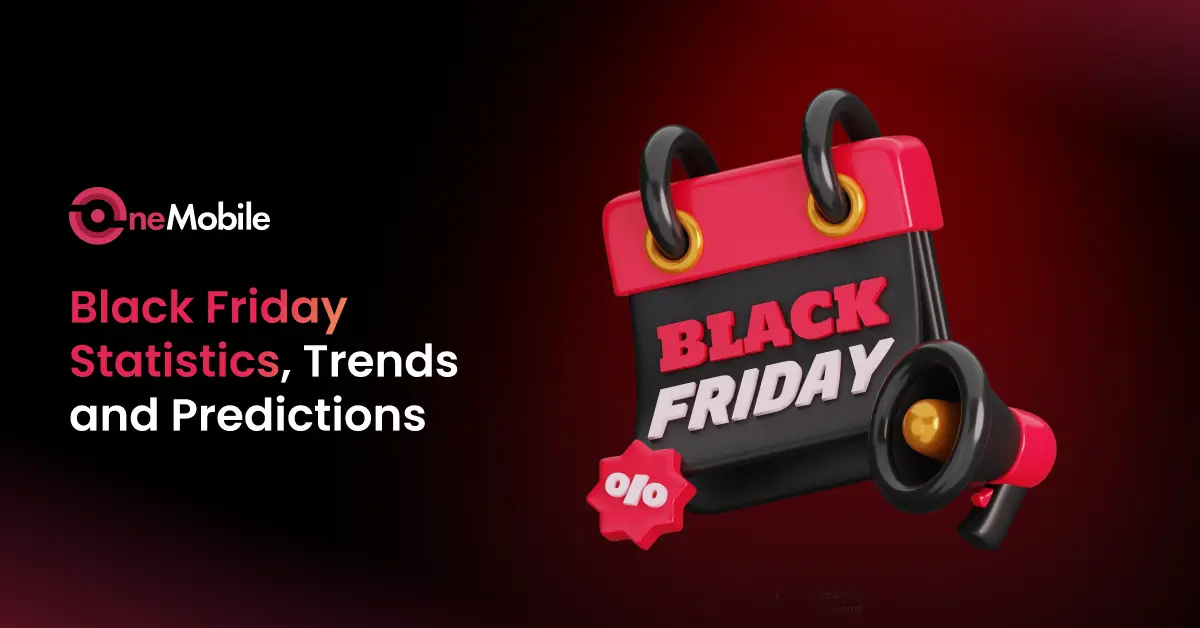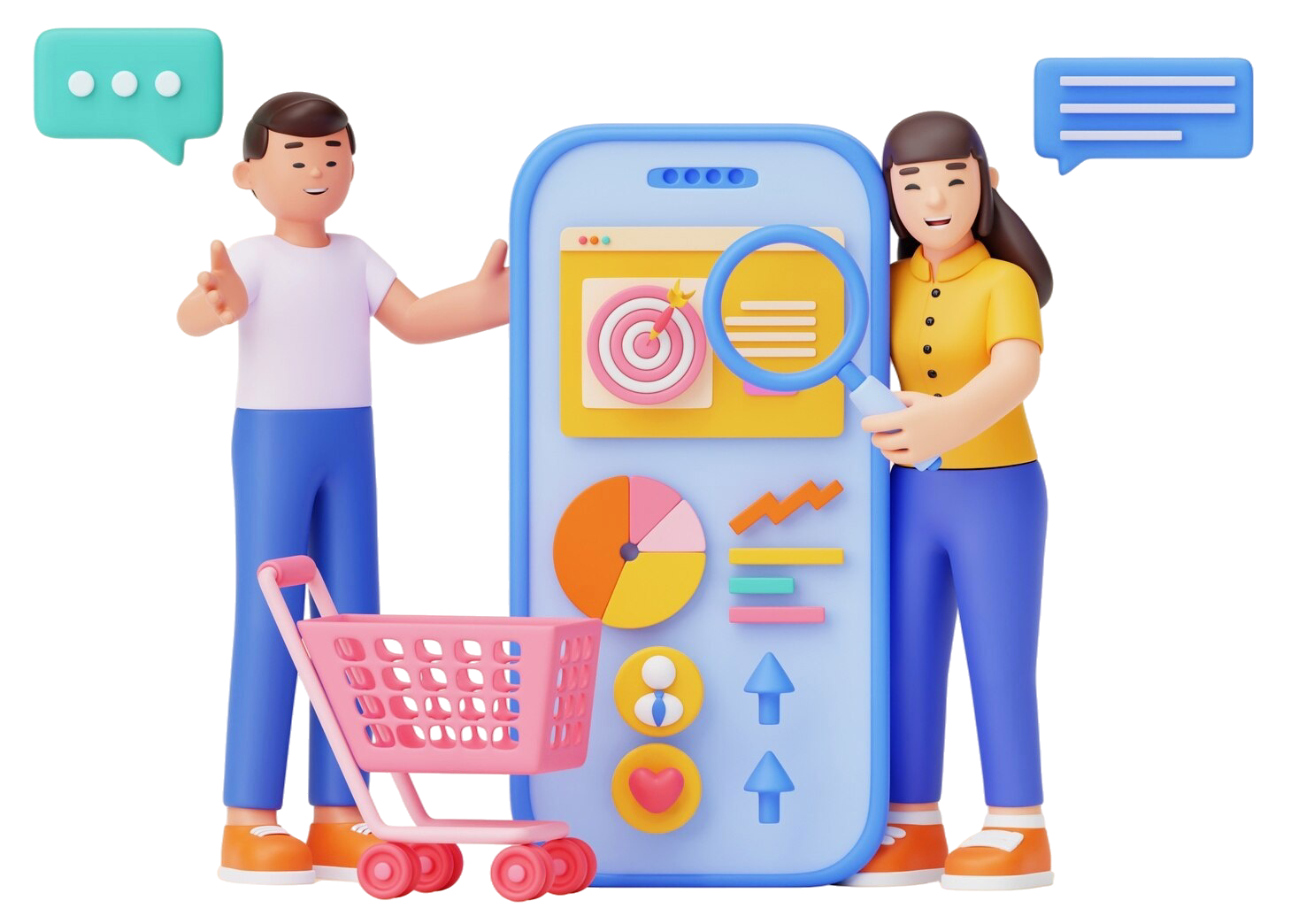- Global Black Friday sales hit $74.4B in 2024, up 5% from 2023.
- U.S. retail sales reached $20B, a 5.8% YoY increase.
- U.S. online spending hit a record $10.8B, surpassing $10B for the first time.
- In-store sales in the U.S. were estimated at $9.2B.
October 24, 2025
Black Friday Statistics and Trends for 2025

Black Friday is fast approaching, and you can’t plan to win it without first understanding what happened last year. That’s why you should read through this article – it breaks down key insights from 2024’s data.
Here’s what you’ll discover:
- Overall sales and growth
- Consumer behavior and shopping trends
- Top product categories and bestsellers
- Device usage: Mobile vs. Desktop
- Geographic highlights and regional trends
- Notable performance metrics and insights
Whether you’re optimizing your next campaign or evaluating results, these Black Friday statistics will help you make smarter, data-driven decisions for 2025. Let’s dive in.
1. Overall sales and growth

Global total sales revenue
Worldwide, total sales revenue for Black Friday reached approximately $74.4 billion (all channels combined), marking about a 5% increase over 2023. (Source: Red Stag’s Black Friday Revenue 2024)
Total sales revenue in the U.S.
2024 was notably the first Black Friday ever to surpass $10 billion in U.S. online revenue. We have the following figures:
- Combined retail sales on Black Friday were about $20 billion, up 5.8% YoY (roughly $10.8B in online purchases and an estimated $9.2B in physical store sales). (Source: Red Stag’s Black Friday Revenue 2024)
- U.S. online spending jumped by about $1 billion versus 2023’s Black Friday. For context, Americans spent more than double online on Black Friday 2024 than they did in 2017 (when online BF sales were ~$5 billion). (Source: Demandsage’s 17 Black Friday Statistics)
Key takeaway
- Invest in scalability, not just traffic. Peak demand keeps rising each year, so stable infrastructure and fast fulfillment now define success.
- Shift marketing budgets toward digital-first campaigns because online revenue is expanding faster than offline, signaling where ROI truly lies.
2. Consumer behavior and shopping trends

- 87.3M Americans shopped online on Black Friday 2024 (down from 90.6M in 2023).
- 81.7M visited stores – the highest in-store turnout since before the pandemic.
- 66% of shopping carts had a promo or discount applied.
- 45% of global shoppers waited for Cyber Week to secure the best deals.
- BNPL usage up 8.8% YoY, totaling $686M in Black Friday online spending.
- 63% of holiday shoppers used both online and in-store channels.
Number of participants in the U.S.
Black Friday 2024 saw huge consumer participation. In the U.S., it remained the most popular single shopping day of the year both online and offline:
- Around 87.3 million Americans shopped online, down slightly from 90.6 million in 2023. (Source: Statistics.blackfriday’s Black Friday Statistics)
- 81.7 million visited stores – the highest in-store turnout since before the pandemic. (Source: Statistics.blackfriday’s Black Friday Statistics)
- Over the full Thanksgiving weekend, 197 million U.S. consumers shopped, just below 2023’s record. (Source: Statistics.blackfriday’s Black Friday Statistics)
Shopper interest in discounts and special deals
Shoppers waited specifically for Black Friday promotions, making it the most strategic shopping moment of the year.
- 66% of carts had a promo or discount applied.
- Average global discount: ~27% off (28% in the U.S.). (Source: NIQ’s Black Friday by the numbers)
- Credit card tracking showed holiday spending declined year-over-year in early November (down 1.4% YoY in the first 13 days of November) as consumers delayed purchases. (Source: Earnest’s Holiday Spending Report)
- In a Shopify holiday survey, 27% of U.S. consumers said they would wait for the major sales events (e.g. Black Friday) to begin buying gifts, taking time to compare prices across retailers.
- A Salesforce study similarly found 45% of global shoppers were “waiting to make purchases until Cyber Week” (late November) to get the best bargains. (Source: Salesforce’s Cyber Week Sales Report)
Use of Buy Now Pay Later (BNPL) payment options
Another notable trend was the increased use of BNPL financing for holiday purchases, especially among younger consumers:
- BNPL usage was up 8.8% YoY, totaling $686 million of online spending on Black Friday. (Source: Demandsage’s 17 Black Friday Statistics)
- Adobe Analytics data showed the average BNPL order was about $189 – roughly 33% higher than orders using traditional payment methods.
- Nearly half (≈48%) of U.S. BNPL users are under age 36 – a far greater share than older age groups. capitaloneshopping.com (Source: CapitalOne Shopping’s BNPL Statistics)
Omnichannel shopping
The growing omnichannel behavior highlights the importance of a seamless, consistent experience across mobile, web, and physical stores.
- 63% of holiday shoppers used both online and in-store channels. (Source: Printful’s Black Friday Statistics)
- 126M customers shopped in stores, and 124M shopped online during Thanksgiving weekend. (Source: NRF’s Holiday Weekend Shopping Report)
- In 2024, only a small minority of customers shop exclusively online (around 7%) or only in stores (~20%), illustrating how common it is to mix channels. (Source: Uniform Market’s Omnichannel Statistics)
Key takeaway
- Align promotions across both online and in-store channels. Use unified pricing, QR codes, and store pickup incentives to merge digital and physical experiences.
- Build pre-Black Friday hype and tease deals early. Use countdowns, wishlists, and “early access” events to capture interest before the sale starts.
- Offer flexible payment methods like BNPL or installments to boost conversions, especially for higher-value items.
- Sync inventory, pricing, and loyalty programs across touchpoints so customers can research online, buy in-store, or vice versa without friction.
- Time your biggest offers strategically — peak discount windows matter more than long sales periods.
3. Top product categories and bestsellers
Certain product categories dominated Black Friday 2024 sales, reflecting consumer priorities and deal-seeking in popular segments.

- U.S. online electronics sales reached $30.1B, up 10.6% YoY during the Black Friday season.
- Online apparel sales hit $24.6B, a 9.5% YoY increase.
- Online toy and gaming sales surged 622% vs. a typical October day.
- Jewelry sales online jumped 561% compared to an average October day.
Electronics and Gadgets
Consumer electronics were among the top-grossing categories globally, as usual for Black Friday.
- U.S. electronics sales surged 334% over October 2024’s average daily sales. (Source: Digital Commerce 360’s Black Friday Sales Report)
- Electronics were heavily discounted, with Cyber Week deals averaging 25–30% off. (Source: Printful’s Black Friday Statistics)
- Amazon leads in consumer value with the highest average discount (41.35%), followed by Target (39.37%) and Walmart (36.15%). (Source: Datawave’s 2024 Electronics Pricing Insights)
Apparel and Accessories
Clothing and fashion items also ranked at the top of shopping lists with impressive growth.
- In the U.S., apparel ranked as the #2 e-commerce category by revenue for the season (Nov. 1 to Dec. 2, 2024) – accounting for about $24.6 billion in online sales (approximately 9.5% growth year-over-year). (Source: Adobe’s Mobile-Driven Cyber Monday Sales)
- Retailers offered substantial markdowns on apparel (often 20–30% off or more), making it an attractive category for bargain-hunters. (Source: Retail Dive’s Black Friday 2024 Highlights)
Toys and Gaming
Sales of toys, games, and hobby items saw explosive growth, a clear sign that many shoppers were securing holiday gifts for children (and themselves).
- Toy sales surged 622% online (vs. a typical October day) – a massive surge, and one of the highest upticks of any category. (Source: Digital Commerce 360’s Black Friday Sales Report)
- Retailers had aggressively promoted toys with steep discounts (toy prices down about 27–28% on average) and many hot items sold out quickly due to demand. (Source: Retail Dive’s Black Friday 2024 Highlights)
Jewelry and Luxury Goods
Jewelry was another star category of Black Friday 2024:
- Jewelry sales jumped 561% online (vs. a typical day in October). (Source: Digital Commerce 360’s Black Friday Sales Report)
- Some of the steepest Black Friday discounts were in the accessories category. For example, diamond earrings averaged ~23% off and rings ~22% off – among the highest markdowns of any product type. (Source: Statistics.blackfriday’s Black Friday Statistics)
Key takeaway
- Promote tech early and bundle accessories or warranties to raise margins in this high-competition category.
- Refresh visuals and product descriptions weekly during Black Week, and highlight limited-time fashion drops to create urgency.
- Plan early holiday gifting campaigns. Secure inventory and promote gift guides for parents and collectors before Black Friday weekend.
- Emphasize exclusivity and limited-stock messaging. Use video and lifestyle visuals to elevate perceived value, not just price.
4. Device usage: Mobile vs. Desktop
More people than ever used smartphones to browse and buy Black Friday deals, yet conversion rates and order values differed between mobile and PC users.

- ~70% of global online sales came from mobile devices.
- 80%+ of Black Friday weekend traffic came from mobile
- In the U.S., 55% of online sales (~$5.9B) were made via mobile.
- U.S. mobile spending grew 12% YoY, outpacing overall online growth.
- Desktop conversion rate was 6.5%, about twice that of mobile.
- Desktop orders had 47% larger baskets than mobile.
- Shoppers averaged 3.6 items per desktop order vs. ~2.9 on smartphones.
Mobile commerce
Mobile continued to dominate both traffic and sales.
- Mobile devices (primarily smartphones) accounted for ~70% of all online sales worldwide over the Cyber Week period (including Black Friday), up from about 67% in 2023. (Source: Salesforce’s Cyber Week Global Sales Report)
- More than 80% of e-commerce website traffic during the Black Friday weekend came from mobile devices (phones or tablets). (Source: Salesforce’s Cyber Week Global Sales Report)
- In the U.S., 55% of Black Friday online sales were made via mobile devices (around $5.9B of the $10.8B total), an increase of ~12% in mobile spending vs. last year. So, mobile online sales grew faster than overall online spending. (Source: Queue-it’s Black Friday Stats)
Desktop shopping
Though mobile generates more traffic, it is desktops that still outperform mobile for big purchases and conversions.
- In the U.S., desktop shoppers converted at about a 6.5% rate, versus roughly 3.2–3.3% on mobile. (Source: Style arcade’s Black Friday 2024 Report)
- Basket sizes on desktop are 47% larger than on mobile. (Source: Adobe Analytics data)
- Desktop users bought around 3.6 items per order on Black Friday, compared to ~2.9 items per order via smartphone. (Source: Queue-it’s Black Friday Stats)
Key takeaway
- Design your campaigns mobile-first, from landing pages and ads to checkout flows. Test speed, visuals, and tap-friendly layouts early.
- Prioritize mobile-exclusive deals or app push notifications to capture impulse buyers during peak hours.
- Use retargeting and personalized emails to bring mobile browsers back on desktop to complete higher-value purchases.
- Add smart upsell prompts and “frequently bought together” recommendations to mobile checkout pages to raise AOV.
5. Geographic highlights and regional trends

- U.S. online sales hit $10.8B, up 10.2% YoY, accounting for 14% of global revenue.
- In Europe, online orders rose ~10%, but total spend fell 4%.
- India’s GMV grew 24% YoY, with premium AOV up 200%.
- Brazil set a record with R$9.4B in online sales, up 10.7% YoY.
- MENA sales jumped 40% YoY, with 60%+ of purchases made on mobile.
United States
The U.S. remains the epicenter of Black Friday activity, and 2024 was no exception. American consumers once again spent more than any other country.
- U.S. shoppers racked up ~$10.8 billion in online spending on Black Friday (Salesforce estimate), which is about 14% of the global online total for that day. (Source: Modern Retail’s Black Friday & Cyber Five Stats)
- U.S. shoppers’ average order values rose ~3% in 2024 vs. Black Friday 2023, indicating people were willing to spend slightly more per purchase (helped perhaps by free shipping thresholds and bigger one-time buys). (Source: NRF’s Holiday Weekend Shopping Report)
- Online sales drove most of the gains (+10.2% YoY) while in-store sales saw only modest growth (~0.7% YoY). (Source: Red Stag’s Black Friday Revenue 2024)
Year | U.S. Black Friday Online Sales | YoY Growth |
2022 | $9.12 billion | +2.3% |
2023 | $9.8 billion | ~+7.5% |
2024 | $10.8 billion | +10.2% |
Europe
Online transactions in Europe were ~10% YoY on Black Friday 2024. However, total online spending in Europe was about 4% lower than Black Friday 2023. (Source: BYYD’s Holiday shopping statistics 2024)
This contradictory result (more orders but less money spent) revealed that high inflation and economic uncertainties in 2024 made Europeans more price-sensitive, leading them to opt for lower-priced goods and smaller baskets on average.
United Kingdom: Black Friday 2024 drove record online spend.
- UK shoppers shelling out £3.63 billion online during the four-day stretch (+5.2% YoY). (Source: The armchair trader’s Christmas Prospects Report)
- According to an Adobe report, on Black Friday, £1.12 billion was spent online (+7.2% YoY).
- In-store and online transactions combined rose 9.5% over 2023. (Source: nShift’s Peak Without the Panic Guide)
- Participation was strong, with more than 1 in 3 Britons planning to shop. (Source: PWC’s UK Black Friday Spending Report)
Germany: Black Week 2024 confirmed its place as a truly omnichannel event:
- 63% of German consumers viewing it as both an online and in-store experience, though 60% preferred shopping online due to better discounts and delivery convenience. (Source: Bright’s Germany Black Week 2024 Report)
- Shopper behavior was mixed: 30% planned purchases in advance, while 44% acted on impulse, drawn by discounts (65%) and the urgency of limited-time offers, especially among younger consumers driven by FOMO. (Source: Bright’s Germany Black Week 2024 Report)
France: French shoppers saw high participation, but spent cautiously on Black Friday due to tighter budgets:
- 80% of French consumers participate Black Friday and Cyber Monday – a record high. (Source: Mediavea’s Bilan du Black Friday 2024)
- 34% of French people typically spend during Black Friday sale events. (Source: Yougov’s BFCM report 2024)
- During Black Week 2024, 13% increase in purchases and an average basket of 66 euros. (Source: Groupe BPCE’s Black Friday 2024 Report)
- In-store sales during Black Week rebounded with a 14% jump in purchase volumes, attracting 9% new customers. (Source: Groupe BPCE’s Black Friday 2024 Report)
- Average spend per person was ~€388, down from €416 in 2023. (Source: Statista’s Black Friday in France Report)
Italy: Consumers remain highly engaged with Black Friday even in a tighter spending environment.
- 86% of Italian consumers planned to shop during Black Friday/Cyber Monday in 2024. (Source: PWC’s BFCM Survey)
- The average planned spend was €229, slightly down from €232 in 2023. (Source: PWC’s BFCM Survey)
- Total turnover in Italy for Black Friday was estimated at €3.8 billion with growth of about +8.6% over the prior year, with 50% via e-commerce. (Source: 9Colonne’s Italy Black Friday Report)
Spain: Spain’s Black Friday event continues to grow, especially in e-commerce, though growth is moderating.
- Revenue growth of only +5% during the month of Black Friday in Spain, with 31% of buyers being new to e-commerce during that period. (Source: LogiCommerce’s study)
- About 65% of Spanish intending shoppers planned to buy Fashion items, followed by Shoe and accessories (56%) and Health and beauty (44%). (Source: Statista’s Spain Black Friday Intentions)
- Most stores in Barcelona offer discounts of around 20% to 30% on Black Friday. (Source: BarcelonaYellow’s Black Friday Overview)
Asia-Pacific
Japan: Shoppers waited to make a few large purchases on Black Friday, rather than many small orders.
- The number of online transactions was flat (0% change YoY) on Black Friday in Japan, yet total spend and average order value climbed by roughly 12%. (Source: Criteo’s 2024 Black Friday Recap)
- About 35% of Japanese retailers saw their sales jump 20% or more on Black Friday 2024, a slight increase in retailer participation vs. last year. (Source: Criteo’s 2024 Black Friday Recap)
New Zealand: Many more checkouts, albeit for smaller basket sizes, keeping total sales flat.
- Kiwis embraced Black Friday 2024 with NZ$175.6 million spent from Friday through Sunday, roughly on par with 2023’s spend. (Source: Worldline’s NZ Retail Trends Report)
- Transaction volumes ticked up (+2.8% YoY) but shoppers were thriftier per purchase – the average transaction value fell ~2.8% to about NZ$83.50. (Source: Worldline’s NZ Retail Trends Report)
- More than half of New Zealanders (51%) planned to shop Black Friday deals in 2024 – a huge rise from 35% in 2023. (Source: RNZ’s Kiwi Black Friday Spending Outlook)
- About 48% shoppers said they’d use Black Friday to afford essential household items, and 51% to buy Christmas gifts on sale. (Source: RNZ’s Kiwi Black Friday Spending Outlook)
India: Black Friday 2024 served as a post-Diwali e-commerce boost.
- GMV up 24% YoY and total order volumes increasing ~17–18% from 2023. (Source: Unicommerce’s data)
- Data from a Unicommerce report indicates that in terms of order volumes, beauty and personal care orders surged 34%, home decor rose 40%, fashion grew ~20%. (Source: Unicommerce’s data)
- AoV rose more than 200% in wearables. (Source: Unicommerce’s data)
- Both marketplaces and brand websites reported order volume growth exceeding 17%. (Source: Unicommerce’s data)
Latin America and other regions
Canada: Canadians turned out strongly for Black Friday 2024:
- National spend up 11% YoY, transaction count increased by 4%, transaction size increased by 7%, sales spiking rose 1,732%. (Source: Moneris’s Data for BFCM 2024)
- In Black Friday, Canadian consumers spent an average of $488. (Source: Locala’s Winning Black Friday in Canada)
- In-store transactions grew 20%, while e-commerce sales revenue rose 31% compared to 2023. (Source: Square’s BFCM Canada 2024)
- Businesses in Canada utilizing Square and Afterpay saw their transactions surge 18% compared to last year, setting a new record of 5.9M transactions. (Source: Square’s BFCM Canada 2024)
Brazil: Black Friday 2024 broke records. (Source: Valor International’s 2024 Sales Beat Forecasts)
- Black Friday online expansion increased 8.4% (in line with market forecasts).
- Order volume from Nov 28th to Dec 1st increased 12%, totaling 14.4M orders.
- Average Order Value (AOV) increased $0.8%, reaching R$555.17.
Africa (South Africa): Black Friday is now a digital-first, week-long event that outperforms most other retail periods on the continent. (Source: Daily Maverick’s South Africa Black Friday Spend)
- Over R30 billion spent across three major banks.
- 14% increase in online customers.
- First National Bank (FNB): +11% YoY spend, R3.2B in purchases; R5.4B processed via Speedpoint.
- Capitec Bank: R25.4B in spend on shopping, fast food and other essential items.
- Absa Bank: +25% YoY in e-commerce transactions.
- Digital payments: 84% of transactions via card; +59% YoY in FNB virtual card spend; +5% in mobile commerce.
Middle East (GCC focus): Localized branding (e.g. White/Yellow Friday) and mobile-optimized e-commerce drove the biggest online shopping event of the year.
- Sales revenue across MENA grew 40% YoY, with order volumes up 19%. (Source: Dubai Business’s MENA White Friday Sales 2024)
- AOV rose from $30 to $36 (2023-2024). (Source: Flowwow and Admitad)
- UAE and Saudi Arabia led the region, with 60%+ of purchases made on mobile devices. (Source: Flowwow and Admitad)
Key takeaway
- United States: Prioritize e-commerce optimization over in-store promotions. Boost conversion by refining checkout, site speed, and remarketing.
- Europe: Offer smaller bundles, flexible payments, and loyalty rewards to appeal to value-driven shoppers.
- United Kingdom: Blend online and in-store strategies – click-and-collect and hybrid promotions work best here.
- Germany & France: Emphasize discounts on essentials and build campaigns around affordability and trust.
- Italy & Spain: Highlight tech and home categories, optimize mobile experience, and support BNPL or installment options.
- Asia-Pacific: Target premium segments and tech-savvy buyers. Localize content and leverage government-backed or cultural sale events.
- Latin America: Localize payment methods (Pix, Afterpay) and offer deeper discounts – price sensitivity is high but trust is growing.
- Africa & Middle East: Double down on mobile-first design and mobile payment options. Promote early to capture regional sale windows (e.g., “White Friday”).
6. Notable performance metrics and insights

- U.S. shoppers spent $11.3M per minute during peak hours.
- Desktop conversions hit 6.5%, nearly double mobile’s 3.3%.
- AI chatbots boosted conversion rates by 9%.
- Average discounts were ~26% globally, 28% in the U.S.
- Shopify merchants generated $11.5B in sales (+24% YoY) from 76M shoppers.
- Late deliveries rose 70% post-Black Friday due to demand spikes.
Peak Online Spending Rate
Black Friday’s scale is perhaps best illustrated by the incredible peak spending moments recorded.
- In the U.S., online spending peaked between 10:00 AM and 2:00 PM (local time) on Black Friday, during which consumers spent about $11.3 million per minute online, on average. This mid-day surge was the busiest online shopping period ever observed for Black Friday. (Source: Retail Dive’s Black Friday 2024 Highlights)
- Shopify reported that 12:01 PM Eastern Time on Black Friday was its all-time peak moment, with sales reaching $4.6 million per minute on Shopify’s platform at that time. (Source: Shopify’s BFCM Recap)
Conversion and Checkout
Conversion performance improved slightly year over year as shoppers were more decisive during Black Friday 2024.
- Desktop conversion rate: ~6.5%. (Source: Statista’s 2024 U.S. Conversion Rate by Device)
- Mobile conversion rate: ~3.3%. (Source: Statista’s 2024 U.S. Conversion Rate by Device)
- Retailers using AI chatbots or virtual assistants saw ~9% higher conversions than those without them. (Source: Style arcade’s Black Friday 2024 Report)
- Cart abandonment: remained high at 73–78%, consistent with typical e-commerce levels. (Source: Contentful’s Black Friday Stats)
Average Order Values (AOV) and Discounts
As discussed in the preceding sections:
- U.S. AOV up ~3% and Europe AOV down ~4%. (Source: Criteo’s 2024 Black Friday Recap)
- The average discount rate on Black Friday was around 26% off list price worldwide (about 28% off in the U.S.), which is roughly on par with 2023 (actually just ~1% lower than last year’s average). (Source: Salesforce’s Cyber Week Global Sales Report)
- Over 50% of all Black Friday purchases in 2024 were influenced by sales or special promotions. (Source: Queue-it’s Black Friday Stats)
Retailer and Platform Milestones
A number of e-commerce platforms hit record milestones during Black Friday 2024, most notably:
Amazon:
- More than 60% of Amazon’s holiday sales came from third-party sellers (mostly small businesses) – a record high share for marketplace sellers. (Source: Amazon’s BFCM sales results)
- Though Amazon didn’t release dollar figures, they did highlight some best-selling categories and items: in the U.S., electronics, toys, and beauty were among the top categories, with Alexa-enabled gadgets (Echo Dots, Fire TV Sticks), Beats headphones, Samsung TVs, Barbie dolls, Play-Doh sets, Shark home appliances, and Medicube skincare devices listed as popular sellers.
Shopify:
- Shopify reported that its merchants collectively rang up $11.5 billion in global sales over the Black Friday–Cyber Monday weekend, a 24% increase from the prior year. (Source: Shopify’s BFCM Recap)
- Over 76 million consumers worldwide made purchases from Shopify-powered brands during that weekend. (Source: Style arcade’s Black Friday 2024 Report)
- More than 67,000 Shopify merchants had their best sales day ever on Black Friday. (Source: Shopify’s BFCM Recap)
In terms of specific retailer milestones:
- Target reported one of its busiest Black Fridays ever in 2024, with online sales exceeding $500 million – a record high for the company. (Source: Demandsage’s 17 Black Friday Statistics)
- Retailers largely deemed Black Friday 2024 a success; in fact, demand was so strong that 33% of shoppers reported being unable to find some items due to stockouts of popular products. (Source: Toolsgroup’s report)
- Walmart Marketplace saw a record-breaking Black Friday 2024, achieving its highest sales day ever with a significant increase in toys and electronics sales. (Source: Walmart’s Marketplace BFCM Report)
Website Traffic and Operational Performance
The sheer volume of traffic during Black Friday 2024 was extraordinary, but all of the major e-commerce sites reported 99–100% uptime:
- Shopify alone processed 1.19 trillion requests and 10.5 trillion database queries over the Black Friday weekend, at one point handling 12 terabytes of data, equating to 284M requests per minute on Black Friday. (Source: Shopify’s BFCM Recap)
- Many retailers deployed virtual waiting room queues for their hottest deals, with one provider reporting 63.6 million visitors passing through online waiting rooms on Black Friday 2024. (Source: Queue-it’s 2024 Holiday Shopping Stats)
- Logistics networks faced immediate post-Black Friday pressure as shipping volumes spiked – late deliveries jumped ~70% versus normal weeks and average delivery times stretched to about 6 days. (Source: Ingrid’s Black Friday Trends 2024)
However, logistics networks faced immediate post-Black Friday pressure as shipping volumes spiked – late deliveries jumped ~70% versus normal weeks and average delivery times stretched to about 6 days. (Source: Ingrid’s Black Friday Trends 2024)
Key takeaway
- Prepare for heavy traffic between 10 AM–2 PM. Stress-test your site, payment gateway, and inventory systems before the rush.
- Streamline your mobile checkout experience – simplify forms, enable one-tap payments, and ensure fast load times.
- Add AI shopping assistants or chatbots to guide and reassure customers in real time.
- Use exit-intent popups, cart recovery emails, and flexible payment options like BNPL to reclaim lost sales.
- Focus on clear value messaging and smart bundles, not just deep discounts – to preserve margins while boosting conversions.
- Confirm fulfillment capacity, communicate delivery timelines clearly, and plan early with carriers.
- Communicate delivery timelines clearly and coordinate with logistics early to handle fulfillment pressure.
Conclusion
From record-breaking mobile sales to the rise of flexible payments and AI-powered conversions, this year’s results weren’t just about volume – they were about evolution. As consumer behavior continues to shift, one thing is clear: brands that prioritize seamless, data-informed experiences across every channel will keep winning, not just on Black Friday but all year long.
Frequently asked questions
How much discount do shoppers get on Black Friday?
Average global discounts hovered around 25–28% off, similar to 2023. Apparel and beauty saw the steepest markdowns (up to 40% off), while electronics and luxury goods were discounted more moderately at 15–25%.
What percentage of Black Friday sales came from mobile devices?
About 70% of online purchases during Black Friday 2024 were made on mobile devices, continuing the shift toward mobile commerce. However, desktop still converted nearly twice as well, with conversion rates around 6.5% versus 3.3% on mobile.
Which regions saw the biggest Black Friday growth?
The U.S. led with strong online growth (+10% YoY), while Europe saw more transactions but smaller basket sizes due to inflation. Asia-Pacific markets like Japan and Australia experienced double-digit growth in average spend, and Latin America showed the fastest adoption, with online payments surging up to 70% YoY.
How do Black Friday sales compare to Cyber Monday?
While Cyber Monday slightly surpassed Black Friday in total U.S. online revenue, Black Friday recorded faster growth and stronger in-store participation. It remains the single biggest day of the year for omnichannel sales globally.
How can retailers prepare for Black Friday 2025?
Focus on mobile optimization, personalized promotions, and real-time analytics. Shoppers now expect seamless cross-device experiences, flexible payment options, and faster delivery – all of which can significantly increase conversions next year.
Table of Contents
Table of Contents
Read more articles
12 Interesting Fun Facts About Black Friday: History, Surprising Stories, and the Truth Behind
By Alexandre Le
October 24, 2025
23 Best Shopify Apps To Rock 2025 BFCM [Hot Deals Included]
By Alexandre Le
October 23, 2025

![23 Best Shopify Apps To Rock 2025 BFCM [Hot Deals Included]](https://onemobile.ai/wp-content/uploads/2024/11/best-shopify-apps-for-bfcm-628x328.webp)





